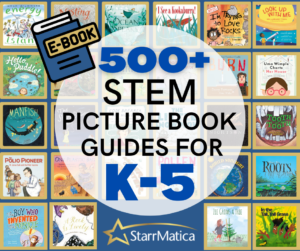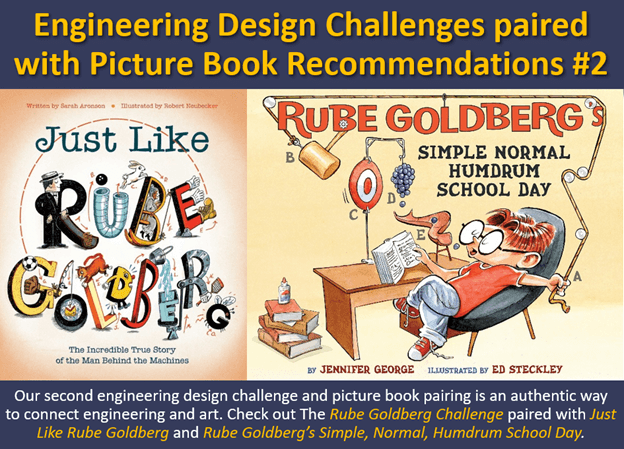Welcome to our second engineering challenge post to help you keep your students engaged the last few weeks of school. (You can find the first challenge here.)
As we shared in the last post, it is essential to note that these posts aren’t intended to provide an entire NGSS-aligned lesson plan. My goal is to focus on sharing a high-quality picture book, an engineering challenge, and question recommendations that you can use as a springboard to create a lesson that meets your specific classroom needs.
Our second challenge is: The Rube Goldberg Challenge paired with Just Like Rube Goldberg by Sarah Aronson and Rube Goldberg’s Simple, Normal, Humdrum School Day by Jennifer George.
Like my first challenge, I’m going to break my own rules and recommend that you read one of the picture books when introducing the challenge. Just Like Rube Goldberg is the story of the real-life Rube Goldberg whom the machines are named after. It is a fantastic story for discussing perseverance, determination, and hard work. Time after time, Mr. Goldberg is turned down yet continues to hone his craft and work toward his goal of becoming a newspaper cartoonist. Several of Rube’s actual machine drawings are included in the text (in addition to a few the illustrator drew) and can be used to introduce the concept of a Rube Goldberg Machine; however, for younger students, the actual drawings may be a bit hard to follow.
I recommend following up by reading just the first three pages of Rube Goldberg’s Simple, Normal, Humdrum School Day. This book is packed with easy-to-follow Rube Goldberg machines. But be careful! When I was doing this challenge with my kids, I only gave them one example from this book (though they were begging to see them all!) because I didn’t want to heavily influence their creations. You can read them the rest of the book after they have created their machines – or leave the text out for them to explore independently. Students could even compare and contrast a contraption the author and illustrator designed to one they created if the students choose the same task as one depicted in the book.
Questions to Ask While Reading:
You could read students the first page of Just Like Rube Goldberg, and ask your students to predict how someone could become a successful award-winning artist and a famous inventor without ever inventing anything at all. Then, you could show your students one of the illustrator’s machines such as “How do you turn off a light?” and ask students: What do you notice? What do you wonder?
As I mentioned before, this book is excellent for discussing character traits. It is also a friendly text for inferring. Here are a few questions you could ask as you read:
- What can you infer about the job of being a cartoonist from the reaction Rube’s father has when Rube told his family he wanted that career?
- What can you infer from the fact that Rube kept drawing and never gave up on his dream?
- What can you infer from the fact that Rube became a celebrity and that readers couldn’t wait to see what he had to say?
- What can you infer from the fact that we still talk about and create Rube Goldberg machines over 100 years after he began drawing his creations?
This text is also the perfect opportunity to discuss with your students how Rube’s engineering degree, art training, and constant practicing of his craft helped prepare him for his eventual success.
The Challenge: Challenge your students to design a Rube Goldberg machine to accomplish an everyday task in a complicated way. Depending on your lesson objectives, you could have your students collectively choose a task and create their own machines to accomplish that task. Then you can share and compare the machines. Or, you could have each student (or group of students) choose a different task to accomplish. You can either have students draw a diagram or actually try and create their inventions depending on your classroom constraints on time and materials. Here is a comprehensive blog post that gives examples of common tasks your machine could accomplish and provides an extensive list of potential materials should you choose to build your machines: https://brainpowerboy.com/rube-goldberg-ideas-machine-tasks-and-materials/
This post also has a nice list of simple materials for younger students: https://tinkerlab.com/engineering-kids-rube-goldberg-machine/
You’ll want to carefully consider your time and materials constraints before beginning the project. Your students should be aware of those as they design their machines. You may also want to add constraints for:
- a minimum and/or a maximum number of objects to be included in the design.
- the amount of space their machine can occupy.
- the period of time their machine has to complete the task from start to finish.
You’ll want to consider your students’ abilities when designing this lesson so you provide the scaffolding they may need. Here are some things to consider:
- Do you need to support your students to figure out what objects to include in their machines? For example, you could give them categories of objects to brainstorm – animals, things that move air, food, objects that make a sound, heavy objects, etc.
- Do your students need to review cause and effect before designing their machines, or do you need to have some other cause and effect support available (like an anchor chart) during the design process?
- Do you want to discuss simple machines with older students and brainstorm lists of materials that could be used for each type?
- Do you want to provide technology for students who prefer to use graphics rather than draw their machines?
The structure of the lesson is up to you and your students. The idea is to get your students experimenting with forces through the lens of cause and effect. With older students, you can even bring in the concepts of gravity and friction.
Next Generation Science Standards Connections:
These engineering performance expectations obviously fit well with this challenge:
- K-2-ETS1-2 Develop a simple sketch, drawing, or physical model to illustrate how the shape of an object helps it function as needed to solve a given problem.
- 3-5-ETS1-1 Define a simple design problem reflecting a need or a want that includes specified criteria for success and constraints on materials, time, or cost.
- 3-5-ETS1-2 Generate and compare multiple possible solutions to a problem based on how well each is likely to meet the criteria and constraints of the problem.
- 3-5-ETS1-3 Plan and carry out fair tests in which variables are controlled and failure points are considered to identify aspects of a model or prototype that can be improved.
This challenge also makes connections with these grade-level PEs:
- 2-PS1-3 Make observations to construct an evidence-based account of how an object made of a small set of pieces can be disassembled and made into a new object.
- 3-PS2-1 Plan and conduct an investigation to provide evidence of the effects of balanced and unbalanced forces on the motion of an object.
- 5-PS2-1 Support an argument that the gravitational force exerted by Earth on objects is directed down.
If you are a StarrMatica Texts: Science Your Way subscriber, you can check out the engineering and forces and motion informational texts below. Remember, each 1st – 5th grade text has multiple reading levels so all of your students can read the same content independently. I recommend having students use these text resources after they have designed and built their own devices. Used this way, the texts help students learn vocabulary and background information they can use to explain what they have learned on their own.
- 5th Grade: Gravity’s Forceful Nature
- 3rd Grade: May The Force Be With You
- 2nd Grade: From This to That
- 2nd Grade: From Trash to Treasure
- 3rd-5th Grade Engineering: Watering Your Garden on Vacation
- 3rd-5th Grade Engineering: Two Ways to Solve a Problem
- 3rd-5th Grade Engineering: Testing Prototypes
- K-2nd Engineering: Sporty Shapes
- K-2nd Engineering: The Importance of Shapes
Not a subscriber? Click here for a free trial to access the texts above.
Cause and effect is the main crosscutting concept that fits well with this challenge. The machines students are creating are entirely dependent on cause and effect chains of events.
And students are using nearly all of the science and engineering practices. They are asking questions and defining problems as they determine a task to complete and the materials they should use. They are developing and using models as they draw their designs. Students are planning and carrying out investigations if they are building and testing their machines. They are constructing explanations and designing solutions, whether building their machines or drawing their designs. When they share their machines with peers, they are obtaining, evaluating, and communicating information. There are many possibilities for incorporating analyzing and interpreting data in upper elementary and using mathematics and computational thinking. For example, you could have your students time how long it takes their machine to complete the task (and/or provide a time constraint for them to address). You could also ask them to create a machine that uses the smallest amount of space as a constraint to incorporate measurement and estimation skills.
Bottom line: Have fun seeing what unique contraptions your students can imagine!
 Are you are looking for additional picture books for your science classroom, check out the Perfect Picture Book Pairing Series that includes one-page guides with activities and discussion questions for hundreds of STEM-themed picture books aligned to every NGSS performance expectation!
Are you are looking for additional picture books for your science classroom, check out the Perfect Picture Book Pairing Series that includes one-page guides with activities and discussion questions for hundreds of STEM-themed picture books aligned to every NGSS performance expectation!
CLICK HERE TO PREVIEW THE PERFECT PICTURE BOOK PAIRING EBOOKS

